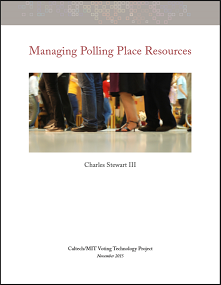Earlier this week, Charles Stewart, III of the Caltech/MIT Voting Technology Project released a report entitled “Managing Polling Place Resources.” This report analyzes wait times at polling places over the past two presidential election cycles and makes recommendations for how election officials can meet the Presidential Commission on Electoral Administration’s challenge that voters not wait more than 30 minutes to cast a ballot. Among the report’s most interesting findings are:
- 75 percent of voters across the country cast ballots in a physical location.
- Average wait times in 2012 varied between 1.7 minutes in Vermont to 42.3 minutes in Florida—nearly twenty-five times as much time.
- Long lines are not ubiquitous, but where they do occur, they are costly in terms of time, lost votes, and confidence.
- African American voters wait twice as long, on average, as white voters. Other minorities are also disproportionately affected.
- Long lines occur “in predictable places on a chronic basis.”
- Wait times for early voting are consistently longer than wait times for Election Day voting at all points during the day.
- The longer people wait in line the more likely they are to lack confidence that their vote will be properly counted. In fact, the very existence of long lines diminishes confidence in the electoral process regardless of whether someone waited in such lines.
The report further applies queuing theory and specialized voting software to demonstrate basic ways in which election officials can diminish wait times while expending minimal resources. Election officials would be wise to read this report carefully and heed Professor Stewart’s advice.
Click here or on the image above to view the report.
